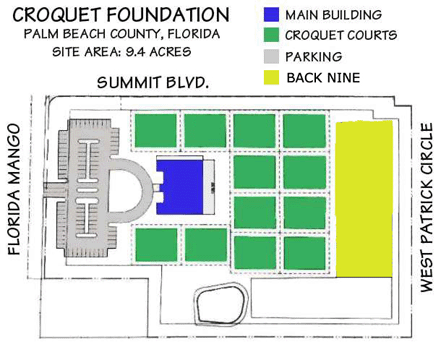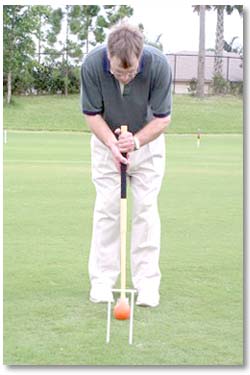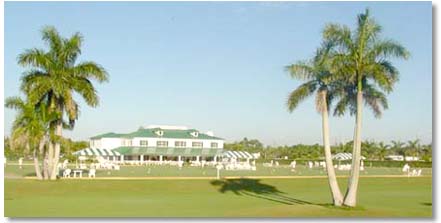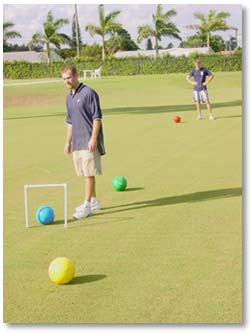
|
Back to |
| The Front Page |
| The Game |
|
The Back Nine restoration at the National Croquet Center |
|
Bob Kroeger, Victoria Albrecht, and Bob Alman discuss the past, the present, and the possibilities photos by Bob Alman except where noted Posted June 15, 2013
|
Once in a while, the editor gets a very good suggestion from a reader for a new article. While the nine-wicket game is often used as the theme of an annual party or fund-raiser, usually with 1890's or Gatsby era costuming, promoters of "serious" croquet have still not figured out a way to seduce these mostly casual and occasional players into the major national associations. Although we don't agree on the how and wherefore, we three are not shy about voicing our strong opinions. It all started with an email:
BOB KROEGER: Bob, It's been several years since the Bob Alman/Bob Kroeger debate on the worthiness of legitimizing backyard croquet was published. Is it time to have a new look at this debate? We could discuss the 9W Nationals, Steve Fluder's use of 9W in his fundraising events, St John's/Annapolis annual match using 9W, and the Maryland Senior Olympics using 9W this September. Your thoughts?
BOB ALMAN: "Several years," Bob? The backyard croquet article we did in CROQUET WORLD is from 1997--more than 15 years ago! A hell of a lot has happened in the interval. But what hasn't happened is any kind of "breakthrough" in capturing a significant number of backyard croquet players for any kind of more advanced, more formalized, more rigorous, Association croquet. The USCA roster of Backyard Croquet members stands at less than 100.
But eleven years ago, the National Croquet Center was established, and now the Back Nine is being restored, thanks largely to the efforts of Victoria Albrecht, the Assistant General Manager, along with NCC club president John Warlick and club pro Bill Mead. One of my first actions when I moved to Palm Beach in 2000 to organize and manage the Center was to change the grass specification for the Dry Retention Area from St. Augustine to Bermuda 419--a grass commonly used on golf fairways that can be cut to 1/2 inch or shorter, and which makes a beautiful surface--one which, as it turns out, is also perfect for half-court Golf Croquet. But in the press of financial woes, Archie Peck decided somewhere around 2008 to stop asking the maintenance crew to keep the lawn in good shape and in the name of further efficiency, he told them to dump bio-trash on it. So it became not only weed-infested, but bumpy. Restoring it will be a big job, but Victoria, Bill, and John are determined to do it, for many good reasons--only one of which is to use it for 9-wicket-croquet.

|
| This original site plan was later revised to include a huge maintenance facility to the right of the irrigation pond. The dry retention area which, when planted with Bermuda 419, became the Back Nine is on the right side of the green-colored regulation lawns. As you can see, the Back Nine has plenty of space for many courts. When it isn't being used for some other purpose, it is set with winter wickets for 9-wicket croquet. The undeveloped area to the left of the Irrigation pond has enough space for two 9-wicket courts. |
So, with your permission, I'm inviting Victoria into this conversation. Victoria: how about starting with a report on the state of restoration of the National Croquet Center's backyard, and how you intend to see it re-developed over the next couple of years?
| Major 9-Wicket events on the Back Nine at the National Croquet Center |
|
Nov 8–10, 2013
For more information or to regmailto:ister, contact Erica Sherman at the USCA by phone or email: 561-478-0760; tournamentusca@aol.com.
|
We got great reviews from members on Bob Alman's SuperSized Croquet tournament in May, and we plan to do more Supersized Croquet events for members and we're considering including the game as part of our promotional activity to the public.

|
| This event for new members of the National Croquet Club in 2013 takes advantage of the terrain on the sloping sides of the Back Nine. It generated a paid SuperSize Croquet party in November hosted by two of the new members of the NCC club, who were given full membership in the USCA as part of their local club membership--demonstrating the potential of the National Croquet Center's many entities and programs to be mutually supportive despite their separate agendas. Photo by Clint Foulkes. |

|
| Bob Kroeger tries out the Back Nine at its playing peak. |
BOB KROEGER: Since we last talked about the USCA promoting backyard croquet as a legitimate sport, there have been five USCA 9 Wicket Backyard National Championships (four in Kansas City, Kansas and one in Harleysville, Pennsyvania). All of these were played on rough long grass by players with a wide range of skills. I have never been more convinced it's a good thing for the USCA to do since it's by far the most recognized and played version of the game in the U.S. With very little expense in equipment, America has literally millions of acres of grass surfaces to play on. Even players who are used to flat putting green surfaces can apply their shot-making skills and tactics to win games on long rough grass, albeit with a little luck! We on the Backyard Croquet Committee are very pleased to see the 2013 Nationals will be played on the Back Nine at the National Croquet Center.
BOB ALMAN: I believe Victoria intends, over time, to take out the bumps (not the slopes, but the bumps) and also the weeds. She wants to use it for overflow for all kind of croquet at the Center. Victoria, I know the NCC budget is tight, but what do you think will actually happen to the Back Nine over the next several years?

|
| Bob Alman set up the Back Nine in March 2002 for four half-courts while the 12 regulation lawns were being used for a major tournament, and snapped this photo while managing the public Introduction to Croquet. The surface was playable, though not fully grown in with Bermuda 419. The clubhouse was not to open for another two months. If you look closely, you can see that the railing on the clubhouse has not yet been installed. As the huge lawn is being restored in 2013, the Back Nine is again being used for overflow space. |
VICTORIA: I think there will be a lot of discussion about the choice of surfaces. Our membership is growing significantly, and on many tournament days and Saturdays we've needed more courts for our six wicket and Golf Croquet payers as well. So the discussion gets complicated. Bill Mead, our pro, is the one who will be setting wickets and working with our groundsmen on the mowing plans for a given week, to provide our players with sufficient courts for each day. The Back Nine courts may not be available at all after an unusually heavy rain. So this is a decision one person alone can't make. We also now have a very good club Croquet Committee planning many tournaments, clinics and additional training in nine wicket and Golf Croquet. While I was instrumental in beginning the rejuvenation of the Back Nine--along with Bill Mead and John Warlick-- it has now become very important to many people, and their voices should be heard.
BOB KROEGER: I think it's important to strike a balance between really good surfaces (flat/predictable) and surfaces where it's 100% luck. When I last played on the Back Nine, I was very pleased with this balance. While I am delighted to see the Back Nine being improved, I wouldn't want it to be made so predictable that top players could easily run the court in one turn-- we want some "personality" retained.

|
| This group of teenagers is part of a revenue event in 2003 on the Back Nine as the surface approaches perfection. Until 2005, the Back Nine was used for many free public and private school activities, in cooperation with the Palm Beach County Sports Commission and the school board. One nearby private school Phys Ed group did a weekly event there. |
BOB ALMAN: I don't think you have to worry about the lawns losing their distinct "personality" in the near future. The budget won't allow a complete Palm Beach style facelift! The president of the NCC resident club, John Warlick, also has strong views about the surface, as well as the chairman of the USCA Nine-Wicket Committee, who told me he prefers courts of all different kinds and shapes for 9-wicket events. John has said that it might be preferable to have part of the lawn in much better shape than the rest: to make good half-court surfaces for overflow into the all-year free public Introduction to Croquet. And Victoria, what about the lawn between the irrigation pond and the Primitive Baptist Church on the corner?
VICTORIA: That space by the irrigation pond has a very thick and luxuriant lawn of long grass that is about the size of two nine wicket courts, just waiting to be developed. The ground there also has a rolling surface, so the first thing we'll have to decide is whether we want the uneven surface or whether it needs to be smoothed and leveled first. The development of that space will have to wait until 2014, at the earliest.
BOB ALMAN: The next events are the Florida regional in November and the first USCA 9-wicket nationals to be held here, in December. Is it safe to assume that the Back Nine will be in the same condition then as now, but with fewer bumps?
VICTORIA: We'll be using the courts for many other purposes before December, for Golf Croquet overflow for the free public Introduction to Croquet on half-courts, for regular nine-wicket casual games, and for at least one SuperSized Croquet event. Although we'll continue smoothing the lawns and reducing the weed population to the extent allowed by our limited budget, ad hoc decisions on the court layout and grass length will be determined by the club's Croquet Committee and addressed by Bill Mead, who supervises the ground crew. They'll depend mostly on the requirements of the event and the desires of the managers.
BOB ALMAN: You told me at one time, Victoria, that there's a possibility that one section of the Back Nine--the southern third of the lawn, for example--could be improved to a standard higher than the other parts. Michael Rumbin (head of the USCA nine-wicket committee) has told me that courts of many different standards could be used for title events. Bob, would it work in a USCA title event to have some lawns that are smooth, some bumpy, some oversized, some on very long grass, some on short, some without any marked boundaries at all? I ask that because those conditions actually apply in America's millions-strong backyard croquet culture, and you have said that the USCA title events should mirror those actual conditions.

|
| By the fall of 2002, the Back Nine was fully grown and well maintained and nearing the state of uniformly green perfection, cut to 1/2 inch, that merited calling it "the most beautiful lawn in Florida." In the background, the first Solomon Trophy matches between the US and Great Britain are being played. |
BOB KROEGER: I think many backyard venues offer conditions that vary and I have no problem with that. Having said that, I'm NOT in favor of smooth flat surfaces for backyard croquet. IMO, smooth flat surfaces are for 6 Wicket Croquet, not 9 Wicket. In terms of size, I think it's important for tournaments to have the same size courts for a particular flight (i.e Championship Flight could have larger courts all the same size while First or Second Flights might have smaller courts). I think it's important to have the courts sized based on making it possible for all players in a flight able to hit end to end.
VICTORIA: I agree and we will work towards attempting to fulfill everyone's needs here at the Center. What's really wonderful is that we are seeing growing interest in all forms of the sport, particularly Golf Croquet, and I appreciate all suggestions on court needs as this helps us plan and be ready.
BOB ALMAN: If Bob Kroeger and Victoria agree, they must be right! But Bob Alman will continue to prefer and recommend fast and smooth turf for 9-wicket games--not necessarily level and flat--because that's what he and his group vastly preferred in his Guerilla Croquet Club of the 80's, before he discovered USCA 6-wicket croquet.

|
| Athletic directors from Palm Beach Altantic University demonstrate tactics and rules in the kicking version of SuperSize Croquet. |
VICTORIA: Bob, the Board of the National Croquet Club has devoted considerable time to determining its membership categories and levels. I do not believe this would currently be an option, however it is something that could be brought to the Club Board, not to me.
BOB ALMAN: Of course I know you or I and nobody can impose this class of membership upon the club board, which, for practical and financial reasons largely relating to taxes, has become independent as one of many entities at the National Croquet Center. And this has produced a situation in which the enterprise must depend on a volunteer croquet club to organize and produce the source of much of the income it needs to survive. Bit surely, Victoria, you and the General Manager and the board of the overall owners, Croquet Foundation of America, have formulated an opinion on what might produce the best chances of optimizing the facility's income and at the same time maximizing the contribution it could make to USCA croquet in serving the founding purpose of the NCC.

|
| A huge and lucrative corporate team building event in 2002 demonstrated the value of having many different lawn areas around the 10-acre facility for competing teams. Three of those widely separated areas were on the Back Nine. |
So the question I have for you and Bob is whether a local club membership at ANY facility might be the best way to promote the significant growth of 9-wicket croquet, now that we have seen that all the other avenues have failed. It so happens that the NCC has a lawn and the bar and dining facilities that could make this work better than anywhere else in America. Wouldn't it be appropriate for the Center to engage in that kind of exploration? Isn't it, in fact, an obligation?
BOB KROEGER: I doubt there would be many who would pay $300 for a 9-wicket membership. Most are not willing to pay $15 to be USCA 9-wicket members! Stand-alone 9-wicket members bear little resemblance to 6-wicket players with regard to fees--in my opinion.

|
| Students from Northwood University playing 9-wicket croquet on terrain in 2003, around one of the signature palm trees set in the lawn. |
BOB ALMAN: But Bob, you might say the same about Golf Croquet players, and there are Golf Croquet club memberships at local clubs all over the world--it's the biggest thing to happen in the sport at the club level in this century. Why shouldn't the same prescription be applied to 9-wicket players? It seems to me this is an opportunity for the club at the National Croquet Center to go where no one has gone before--no USCA club, anyway--and offer a special membership for 9-wicket play, limited to the Back Nine. Why not? Isn't that partly what a national headquarters facility is for? If not here, where? If not now, when? And Bob, your $15 gives 9-wicket players access to only one title event, as I understand it, and an issue of the USCA NEWS. But for their $300--or whatever--at the NCC, they could get a GREAT bar and social environment, and an elegant dining room. Maybe nobody would join in that category--they may choose another category. But what's the downside of trying it at the NCC?
VICTORIA: Our players who started with the game of Golf Croquet here at the Center are for the most part now all full members of the resident National Croquet Club, and we will continue this model. Many of these players have now started to also play six wicket as well as nine wicket. We see this as the same path for someone who would come to the Center wanting to start their croquet "career" with nine wicket, since our mission is to promote all four versions of the game, and almost all of our players play at least two versions regularly.
BOB ALMAN: Victoria, I think you mean that the PRESENT Full Members started with Golf Croquet, and that's true. But there are also hundreds of other members who started with Golf Croquet and who are no longer members, because there's no room for them in the current menu of membership categories. There are many other questions I could ask, but I'll content myself with two final ones: Do you foresee a time when there are so many Full Members they can't be accommodated to their satisfaction on the site, and you will therefore allow other classes of membership that cost less and offer limited court time? And finally, may I assume the immediate purpose of having these 9-wicket title events at the NCC and developing the Back Nine is to continue the strategy of the USCA Nine-Wicket Group of the past--that is, "promoting" nine-wicket players to American 6-wicket croquet?
VICTORIA: If those Golf Croquet players are local people, we certainly want to contact them and invite them to come back. Insofar as foreseeing a large pool of full members in the National Croquet Club: Yes, I do envision a day when we will need to limit the number of new full memberships. Wouldn't that be wonderful? As for the development strategy, we will continue in our mission to promote nine wicket croquet in partnership with the USCA and we're delighted to be able to host the nine wicket championships this year and in future years.
BOB KROEGER started playing competitive croquet at age 11, and since 1984, has been professionally involved with the sport. His many competitive achievements include two National Championships as well as several Regional and Invitational titles. Bob was a member of the United States National Croquet Team from 1988 to1993, competing in the prestigious 1993 MacRobertson Shield event then held in Australia. In 1999, he was inducted into the Croquet Hall of Fame. He is currently and has been for several years, the Director of USCA Instructional Schools at the National Croquet Center in West Palm Beach. Currently, Bob concentrates his efforts on promoting all forms of the sport, specifically, tournament six-wicket croquet and competitive nine-wicket backyard croquet. He is featured with fellow croquet pro Teddy Prentis in six USCA instructional videos--one on shot-making, four on strategy, and one on backyard nine wicket croquet--all on DVD. Bob is also the author of the Official USCA Shot-making Manual along with a comprehensive three-volume set of Croquet Strategy Books he wrote with Teddy. When not involved in croquet, Bob is a freelance musician, videographer, photo restorer, and recording engineer on Cape Cod. He loves spending time with his wife Deborah and their cat Sofia.
VICTORIA ALBRECHT joined the National Croquet Center's resident club in 2006 after her first free public lesson, and quickly became an enthusiastic tournament competitor and a key volunteer. After being nominated by the Croquet Foundation of America she became Chairman of the Development Committee and as part of her work she has clarified their mission, developed the first outreach programs, and developed and implemented the CFA website. As part of the Special Olympics Program she worked with Palm Beach County to help form the first Palm Beach County Special Olympics Croquet Club. Victoria also worked with the State of Florida through the Florida Sports Foundation, whose mission is to promote sport and tourism in Florida, to have Croquet recognized as an official sport in the state. As part of this effort the City of Delray Beach and the City of Palm Beach Gardens held their first ever Croquet Senior Games at the National Croquet Center in 2013, and both cities are scheduled to continue holding their games at the National Croquet Center in future years, providing public awareness of croquet throughout the county. She also was able to have Croquet recognized as a participating sport by the Senior Health and Fitness Day organization, where more than 100,000 older adults participate in activities at more than 1,000 locations throughout the U.S. in an annual National Senior Health & Fitness Day, celebrated annually in May as Croquet Day at the National Croquet Center. Thanks to Victoria, croquet is now shown regularly on Florida Tourism media. In 2012, the CFA Board asked Victoria to take on an additional role as Assistant General Manager at the National Croquet Center. She is uniquely suited to this job, having spent years at Fortune 100 companies, owning several small businesses as well as having significant financial and management experience. Victoria takes seriously the mission of the CFA to promote all four forms of croquet, and incorporates that vision into her work at the Center. The restoration of the Back Nine and the possible creation of three additional courts on the ten-acre site all fit that mission.